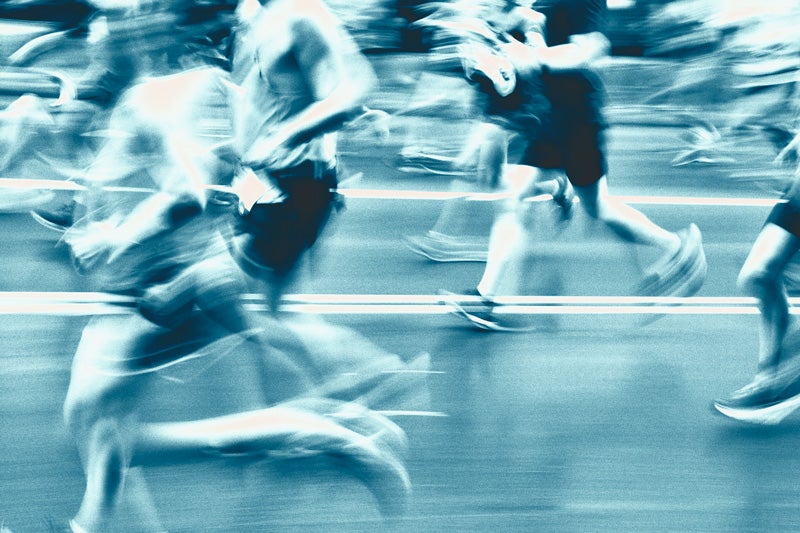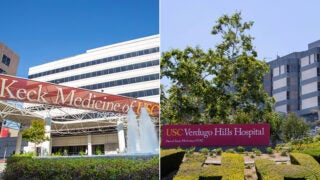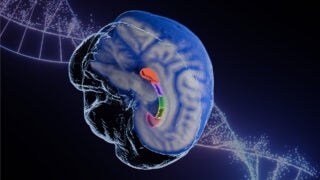Sports Medicine Innovations That Help Weekend Warriors Stay in the Game
Experts in physical therapy, orthopaedics, ophthalmology and more help people stay active for longer.
Call them recreational athletes. Couch-to-5K joggers. Weekend warriors. Whichever name you use, they’re the ones who wait all week to hit the soccer field, basketball court or running trail on Saturday morning. They’re up at 5 a.m. for a long run before work or playing softball until the lights switch off at night. They might not have fancy endorsements or lucrative contracts like the professionals, but they bring just as much heart to their sport.
Juggling work and family while still leaving it all on the field every week can take its toll on the body, though. The sporadic activity that defines these intermittent athletes makes them prone to injury. “Weekend warriors represent a large number of the patients that we see,” says Keck Medicine of USC orthopaedic surgeon Frank Petrigliano, chief of the USC Epstein Family Center for Sports Medicine.
Petrigliano is the new head team physician for the L.A. Kings hockey team and a team physician for USC Athletics. Before he crossed town to join Keck Medicine in August, he served as a team physician for UCLA’s student-athletes. But he gives the same quality care to the first-time marathoner as he does to the college quarterback.
That’s part of the philosophy of USC’s sports medicine specialists, says Jay R. Lieberman, director of orthopaedic surgery at Keck Medicine. “Whether it is a professional athlete, a USC athlete or a weekend warrior, the goal is the same: We will use cutting-edge technologies to help patients attain their athletic goals,” says Lieberman, chair of the Department of Orthopaedic Surgery at the Keck School of Medicine of USC. Across USC, disciplines like orthopaedics, physical therapy and stem cell science are uniting to support people who are active — and want to stay that way.
KECK MEDICINE OF USC SPORTS MEDICINE IN THE SOUTH BAY
The L.A. Kings’ practice facility, the Toyota Sports Performance Center in El Segundo, is a sports mecca in the ice hockey hotbed of Los Angeles County’s South Bay. The center, which opened in 2000, has now branched out to offer specialty services in sports medicine through the newly opened USC Epstein Family Center for Sports Medicine. This development brings USC’s sports medicine care not just to the L.A. Kings, but also to athletes of all ages and across all sports in the South Bay, including children on youth teams. “There aren’t many institutions in the United States that combine a sports medicine program, sports performance facility and care for a pro team all under one roof,” Petrigliano says.
As head of the new facility, Petrigliano oversees a staff of physicians and other health-care providers who listen to and evaluate patients — and then customize their treatments for each one. These treatments are multifaceted. Staff members work with athletes to prevent reinjury and stay healthy by teaching them to embrace proper conditioning and strengthening. “At a certain point in your life, your athletic career is not about intensity, but longevity,” Petrigliano says. But USC faculty members even go beyond surgery and prevention. Some of them are working in the laboratory to use science for the benefit of future patients.
One of the biggest challenges to athletes in sports like soccer or skiing is knee injuries. When people damage their cartilage — the lining between bones — it grows back slowly, if at all. USC scientists want to give cartilage a boost using the power of stem cells.
Denis Evseenko, associate professor of orthopaedic surgery and director of skeletal regeneration at the Keck School of Medicine, aims to go to the heart of the problem. “Drugs like ibuprofen reduce pain and inflammation, but they do not induce regeneration of tissue. Stem cell therapies are designed to regenerate the tissues, to restore them to as close to normal as possible,” he says.
After years of painstaking research, he and Petrigliano have pioneered a stem cell therapy for what are called focal cartilage lesions. These usually happen in young people who suffer a traumatic knee injury. The knee is a common site of such lesions because injuries to that joint are often associated with ligament or meniscal tears. “The lesions usually involve an area a few square centimeters where the cartilage at the joint has been damaged and does not regenerate,” Evseenko explains. Unfortunately, the lesions also put patients at risk for osteoarthritis later.
The team developed a patch infused with stem cells. Called Plurocart, it’s nearing the clinical trial stage. Surgeons place the patch on a lesion where the stem cells are intended to create new cartilage cells. “What this preventive therapy will do, we hope,” Evseenko says, “is delay the onset of osteoarthritis and perhaps completely eliminate the need for total joint replacement.”
He and Petrigliano have also pioneered a new drug that aims to promote cartilage development while tamping down inflammation. They’re now laying the groundwork to take this drug into clinical trials.
Patients seeking care at Keck Medicine of USC have access to new treatments spurred by academic research, Petrigliano says. “Giving them a cutting-edge approach to deal with their pain and get them back in the game is something unique to what the USC Epstein Family Center has to offer.” This approach to athletic injuries not only touches on advances driven by science — it also ventures into fields some might not immediately identify with traditional sports medicine.
AN EYE ON SPORTS MEDICINE
Vision probably isn’t the first thing that comes to mind when you think of sports medicine, but eyesight is critical to most types of athletic performance. “Eighty percent of the information you take in about the environment comes in through your eyes,” says Charles Flowers Jr., associate professor of clinical ophthalmology. He leads the USC Roski Eye Institute Sports Vision Training Center of Excellence.
As you learn a new activity, the brain rewires itself, a process called neuroplasticity. New neural connections ease repetition of that task. “Just like you can go to the gym and lift weights to get bigger muscles,” Flowers says, “you can actually train the brain’s visual system to increase the number of connections to certain areas to enhance your visual processing and your visual performance.”
To help keep players in peak condition, a growing number of professional sports teams incorporate vision training into their practice regimen. Flowers anticipates that athletes soon will use augmented reality to simulate gameday conditions, and this will strengthen their peripheral vision and enhance visual processing speed, which are critical for detecting motion. But weekend warriors already can benefit from exercises that Flowers prescribes for training at home.
Flowers teaches patients to fix their vision on a central point, then consciously notice everything on the periphery. “When you engage in your sport, that instinct will kick in to be more aware of your peripheral setting,” he says.
He also has patients place sticky notes on a wall at eye level. While facing the wall, athletes can quickly look from one note to the other. These rapid eye movements, called saccades, are crucial in sports like tennis and basketball. In another exercise, athletes can practice watching a car drive away and out of sight. These smooth-pursuit exercises sharpen the ability to track a ball or puck’s trajectory.
Finally, Flowers recommends that athletes put away their cellphones before competition. “It shuts down your peripheral vision,” he says, “which can throw off your performance.” Devices can help athletes in other ways, though — and USC faculty members have expertise there, as well.

WEARABLES CAN PREVENT INJURIES
Track coaches still use stopwatches, but the universe of modern sports technology can make them seem quaint. Today’s tracking devices and wearables help even recreational athletes monitor their fitness and look for signs of overtraining and imbalances. That awareness can prevent injury.
“With the advances in wearable technology, fitness tracking devices are becoming feasible, practical and affordable for people to use to keep themselves healthy and exercising,” says E. Todd Schroeder, associate professor of clinical physical therapy and director of the Clinical Exercise Research Center at the USC Division of Biokinesiology and Physical Therapy. Runners should look for a device that measures both heart rate and distance, while soccer players need to track sport-specific measures like peak speed and time spent running backward, he says. But don’t get too complicated.
“Review a device’s user-friendly features and make sure it’s something you’re comfortable using,” Schroeder says. Otherwise, you’re likely to stop using it. With these devices, athletes may know more about every workout — down to the number of breaths they’re taking — but how can they make sense of all the data?
That’s the problem being tackled by the new master’s program with a sports science emphasis at the USC Division of Biokinesiology and Physical Therapy. “The new program focuses on training our students to take the data from this new technology, apply it and make it actionable,” Schroeder says. Graduates will have the skills to translate the data into training recommendations to help athletes perform at their peak.
Wearable devices that can help with injury recovery also have grown popular as athletes look for ways to bounce back faster. Some gizmos, known as neuromuscular electrical stimulation devices, trigger muscles to contract. When athletes attach the electrical leads over their calf muscles, the device causes the muscles to contract, which increases blood flow to the leg. That may reduce fatigue and accelerate recovery. And hand-held vibrating massage devices use high-speed oscillation to reduce soreness and loosen tight muscles. Not all advances in sports therapy require a high-tech wearable device, though.
Restricting blood flow during exercise training is one of the latest techniques to help athletes recover from ACL surgery and other lower-leg injuries. A cuff tightly wrapped around an athlete’s upper thigh reduces blood flow to the lower leg. “It allows an individual to work out with a very light weight on the leg and get the same benefits of using heavy weight-resistance training,” Schroeder explains. “You can start someone on an exercise protocol much faster after surgery, so they recover faster. It’s really taking off among physical therapists as a modality for recovery and rehabilitation.”
IN IT FOR THE LONG RUN
When brainstorming how to best serve patients at the Keck Medicine of USC sports medicine treatment center at the Toyota Sports Performance Center, Petrigliano and his fellow specialists placed a high priority on offering extended hours and walk-in appointments. “If someone has an acute injury, we want to get them seen as soon as possible,” Petrigliano says. But he also has long-term recovery in mind.
“In Southern California, a lot of people are going to stay very active into their older age,” Petrigliano explains. “We want to make sure they are able to do that. So we try to provide them as much information as we can so they can avoid having to see us for preventable injuries in the future.”
That sets up runners, tennis players and the occasional kickboxer with more knowledge and more time to safely and passionately pursue the sports that they love. After all, no athlete likes being sidelined — and USC’s specialists want to see their patients healthy again, too.
The Epstein Family Center for Sports Medicine was made possible through a gift from Daniel and Phyllis Epstein.



